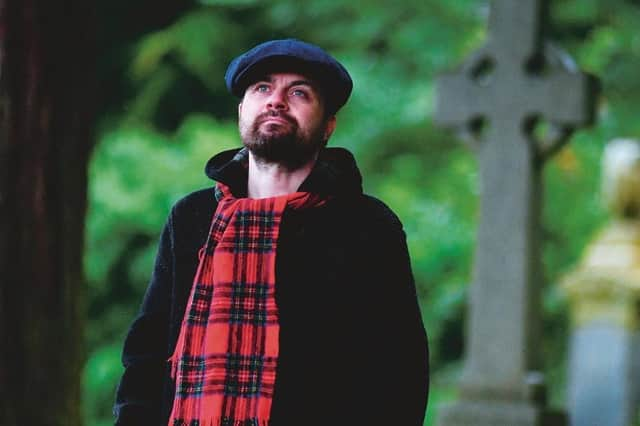Book review: A Tomb With A View, by Peter Ross


In the 18th century there was a fad for poems by a group later dubbed “The Graveyard Poets”. The most famous is Thomas Gray’s Elegy Written In A Country Churchyard, from which we get phrases like “far from the madding crowd” and “mute, inglorious Miltons”; but there were plenty more, such as Robert Blair’s The Grave, Edward Young’s Night-Thoughts and Thomas Parnell’s A Night-Piece On Death. In recent years I have had read and reviewed a number of books on graveyards, the most memorable being a charming novel by Neil Gaiman (which is really The Jungle Book in a cemetery), various books by the inveterate haunter Iain Sinclair, Jean Sprackland’s poetic These Silent Mansions and Peter Stanford’s How To Read A Graveyard: Journeys In The Company Of The Dead.
Peter Ross, an award-winning journalist formerly of this parish, makes a fine contribution to this library of books about “being planted” (as we say in the Borders) with A Tomb With A View. It demonstrates his great skill as a listener. Though I have some caveats, I have nothing but admiration for his way to winkle out a story from the living as well as paying homage to the dead.
Advertisement
Hide AdI, like Ross, am fond of graveyards, which seem both eerie and calm at the same time. I have favourite graves: “In loving memory of my dear father, Christopher Lauder, who was killed by lightning 14th June 1888, aged 29 years, also my dear mother Agnes Graham, who died 6th March 1929, aged 67 years” in Lilliesleaf Kirkyard. Or one I found recently in Hownam – “To the memory of Ann, daughter of George Rutherford, Shepherd, who died at Wearystreams, March 9th, 1819, aged 20 years”.Ross vividly captures the way in which a graveyard is a “library of the dead”. He seeks out particular graves and stumbles over unlikely ones, and does his research thoroughly into the brief biographies. They are, as Thomas Gray wrote, “the short and simple annals of the poor”.
Ross is better on those who tend the dead. The chapter on Islamic funerals is done with grace and dignity, and he has an eye for the toothsome story; so we have the “Queerly Departed” tour of LGBTQ+ graves, the “Stepney Amazon” Phoebe Hessel who enlisted as a man, the difficulty of unconsecrated graves, a Dublin tour guide of Glasnevin who hanged himself there, a “Wild Boy” reminiscent of Caspar Hauser in Hertfordshire and the rise in ecological burials. One of the themes that intertwines his sensitive interviews is that graveyards are a thing of the past. Most of us will be cremated. The rituals around this are yet to harden: two of my grandparents are in a plot with a headstone, the other two are under flowers in my parents’ garden.There is an intriguing chapter of ossuaries, or bone crypts, in England; although I was slightly disappointed that Ross did not look at the more baroque versions of these, such as the Capuchin Chapel on the Via Veneto in Rome. In a manner there is a synergy in this chapter with Sue Black’s work – what do we learn about the dead and from the dead? Although I would always counter, what does it tell us about living? There is a genuine tenderness in the descriptions of those who, voluntarily, seek to keep those at rest safe.
Much though I enjoyed and was moved by the book, there is a slight problem in terms of tone. When Ross is telling the stories of others, he is polite, cautious and respectful. They speak for themselves and he gives them space to speak. In some of the other parts there is some writing which I would describe as being a bit flash. The title itself – a pun on EM Forster – is subtitled “the stories and glories of graveyards”. Elsewhere we get “a coffin cacophony – as they gab and gob”, and “Milanese socialites, militant suffragettes, millionaire time-travellers”. The introduction ends “may you read in peace”. There are numerous alliterations and internal rhymes, which rather draw attention to the prose rather than to the subject. I am well aware of the lure of the fancy phrase, but they are what I cut out in edits. It might also have benefited from a little more of the boring practicalities: the Kirk owns the building, the council has the upkeep of the graveyard, if it is a functioning one.
These are cavils, because the book does convey a sense of what the “taphophlle” is after. It is both a sense of the past and an awareness of mortality. Ross says “Notice everything. Regard each stone as a story waiting to be told” and that seems a very good way of being a journalist, even if the dead are dumb. It made me count over in my head an old rhyme inscribed outside Kelso Abbey – “Remember man as you pass by / As you are now, so once was I / As I am now, so will you be / Prepare for death and follow me”.
A Tomb With A View. by Peter Ross, Headline, £20
A message from the Editor:
Thank you for reading this story on our website. While I have your attention, I also have an important request to make of you.
The dramatic events of 2020 are having a major impact on many of our advertisers - and consequently the revenue we receive. We are now more reliant than ever on you taking out a digital subscription to support our journalism.
To subscribe to scotsman.com and enjoy unlimited access to Scottish news and information online and on our app, visit https://www.scotsman.com/subscriptions
Joy Yates
Editorial Director